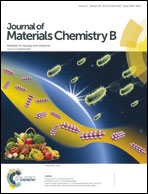Quaternized chitosans bind onto preexisting biofilms and eradicate pre-attached microorganisms
Abstract
Quaternized chitosans, N,N,N-trimethylchitosan (TMC), with different degrees of quaternization were synthesized by reacting methyl iodide with chitosan. The reaction was confirmed by FT-IR and 1H-NMR characterization. Antimicrobial assay showed that the prepared TMC had potent biocidal effects against planktonic Gram-positive bacteria Staphylococcus epidermidis, Gram-negative bacteria Escherichia coli, and yeast Candida albicans. Bacterial and fungal biofilms were formed on poly(methyl methacrylate) (PMMA) films and then treated with TMC aqueous solution. Zeta potential measurement suggested that TMC bonded onto the preexisting biofilms. Biofilm-binding kinetics was evaluated in UV studies using phenyl group-labeled TMC as a model compound, which revealed that quaternized chitosans bonded onto the preexisting biofilms rapidly. Colony-forming unit (CFU) determination and SEM, confocal laser scanning microscopy (CLSM) and fluorescence microscopy studies demonstrated that the bonded TMC had powerful biocidal activities to eradicate the pre-attached bacterial and fungal cells in the preexisting biofilms. The biocompatibility of the TMC samples with rat skin fibroblast cells was evaluated in the MTT assay.


 Please wait while we load your content...
Please wait while we load your content...